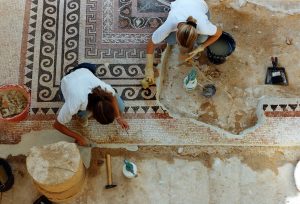Herod the Great enjoyed living in sumptuous palaces and fortresses erected in the midst of the desert of Judea. Masada is the most spectacular example, and is linked to the Zealots’ tragic resistance to a Roman siege.
The fortified citadel is built on the summit of a rocky spur overlooking the coastline of the Dead Sea. Here, Herod ordered a residential palace (the Northern Palace), a large thermal bath complex (the Large Baths), living quarters for officers (Liskat Hamefaket), and another palace for representation (the Western Palace). The latter palace was the first imperial building erected on the site, and probably served for administering the realm and welcoming visiting dignitaries. Some of the halls have refined polychrome mosaic pavements from the first century BC.
The CCA, Centro di Conservazione Archeologica, implemented a program for their conservation based on applying measures to prevent damage, on-site conservation with lime-based materials, and programmed maintenance.
During the treatment, a training course was held for technicians of the Masada National Park, who were subsequently assigned the task of periodical maintenance

